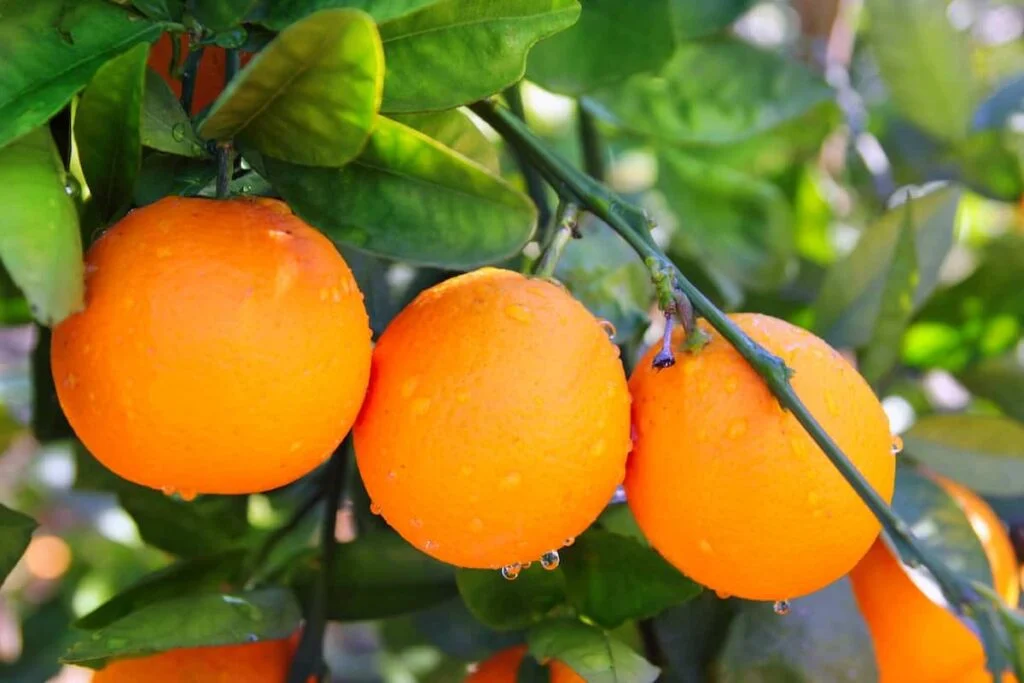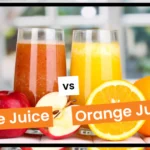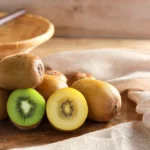Regarding juicing, oranges are a popular choice due to their refreshing taste and high vitamin C content. However, not all oranges are created equal when it comes to juicing. Some varieties are sweeter, while others have a more tangy flavor. Additionally, specific oranges yield more juice and are easier to extract than others.
This comprehensive guide will explore the top 7 oranges perfect for juicing. We will delve into their flavor profiles, juice yield, nutritional benefits, and overall suitability for juicing purposes. Whether you’re a seasoned juicer or just starting, this article will help you decide which oranges to choose for your next juicing adventure.
7 Best Types Of Oranges For Juicing

When it comes to juicing oranges, several varieties stand out for their flavor, juiciness, and nutritional value.
Here are seven of the best types of oranges for juicing:
Valencia Oranges
Valencia juicing oranges are among the most popular choices due to their high juice content and sweet flavor. They are known for their thin skin, making them easy to peel and squeeze. Valencia oranges are also rich in vitamin C and other essential nutrients, making them a healthy choice for juicing.
Navel oranges are another excellent option for juicing. They have a sweet and tangy flavor with a hint of acidity, which adds a refreshing taste to the juice. Navel oranges are seedless, making them convenient to use for juicing purposes. They are also packed with vitamin C and dietary fiber.
Blood Oranges
Blood oranges are known for their vibrant red flesh and unique flavor profile. They have a sweet and slightly tart taste with berry-like undertones, which can add complexity to your orange juice. Blood oranges are also rich in antioxidants, such as anthocyanins, which give them their distinctive color.
Cara Cara Oranges
Cara Cara oranges for juicing are navel oranges with pinkish-red flesh. They have a sweet and tangy flavor similar to regular navels but with subtle hints of cherry and raspberry. The unique taste of Cara Cara oranges can elevate the flavor of your orange juice. Additionally, they contain high levels of vitamin C and lycopene.
Mandarin Oranges
Mandarin oranges, tangerines, or clementines are small citrus fruits that make excellent additions to orange juice blends. They have a bright and sweet flavor with a hint of tartness. Mandarin oranges are easy to peel and separate into segments, making them convenient for juicing. They are also a good source of vitamin C and dietary fiber.
Satsuma Oranges
Satsuma oranges are a type of mandarin orange that originated in Japan. They have loose and easy-to-peel skin, making them ideal for juicing. Satsumas have a sweet and tangy flavor with low acidity, making their juice taste refreshing and mild. They are also rich in vitamin C and other essential nutrients.
Seville Oranges
Seville oranges, known as bitter oranges, are not typically consumed fresh but are widely used for making marmalades and citrus-based sauces. However, their tart and bitter flavor can add a unique twist to orange juice blends. Seville oranges have a thick peel and contain high vitamin C and dietary fiber levels.
Best Way To Juice An Orange
The best way to juice an orange involves a few simple steps that will help you extract the maximum amount of juice while minimizing waste.
Here is a detailed guide on how to juice an orange effectively:
- Select oranges that are firm, heavy for their size, and have a vibrant color. Ripe oranges tend to yield more juice and have a sweeter taste.
- Wash the oranges thoroughly under running water to remove any dirt or residue. Pat them dry with a clean towel.
- Allow the oranges to come to room temperature before juicing for optimal juicing. This helps in maximizing juice extraction.
- Gently roll the orange on a hard surface using your palm. This helps to break down the internal membranes and release more juice.
- Using a sharp knife, cut off both ends of the orange, creating flat surfaces on each side.
- Depending on your preference and the size of your juicer, you can either halve or quarter the orange. If using a handheld juicer, splitting the orange is usually sufficient. If using an electric juicer, quartering may be necessary.
- Hold one-half or quarter of the orange over a citrus juicer or reamer, cut side down. Apply gentle pressure and twist back and forth to extract the juice. Continue this process until all the juice has been extracted from each piece.
- If you prefer pulp-free juice, strain it through a fine-mesh strainer or cheesecloth to remove any remaining pulp or seeds.
- Pour the freshly squeezed orange juice into a glass and serve immediately for maximum freshness and flavor.
Top Tips For Juicing Oranges
Whether you are new to juicing or looking for some tips to enhance your orange juice experience, here are some top tips to help you get the most out of juicing oranges:
Choose ripe and juicy oranges.
The key to getting delicious and flavorful orange juice is to select ripe and juicy oranges. Look for oranges that have a bright and vibrant color, feel heavy for their size, and have a slight give when gently squeezed. These signs indicate that the oranges are ripe and will yield a good amount of juice.
Wash the oranges
Before juicing, it is vital to wash the oranges thoroughly to remove any dirt, bacteria, or pesticide residues that may be present on the skin. Use cool running water and gently scrub the oranges with a vegetable brush. Dry them with a clean towel before proceeding with juicing.
Roll or warm the oranges
To extract maximum juice from the oranges, roll them on a hard surface using gentle pressure or warm them slightly before juicing. Rolling helps to break down the internal membranes and release more juice while warming the oranges makes the juice flow more easily.
Cut the oranges
Once you have prepared the oranges, cut them in half crosswise. If you have a manual or electric citrus juicer, place one-half of the orange onto the reamer and press down firmly to extract the juice. If you use a different type of juicer, follow the manufacturer’s instructions for extracting juice from citrus fruits.
Strain if desired
If you prefer pulp-free orange juice, strain the freshly squeezed juice through a fine-mesh strainer or cheesecloth to remove any pulp or seeds. This step is optional and depends on personal preference.
Serve immediately
Orange juice is best enjoyed when fresh and at its peak flavor. After juicing, serve the orange juice immediately to retain its nutritional value and taste. If you need to store it for a short period, keep it in a sealed container in the refrigerator for up to 24 hours.
Experiment with variations
While freshly squeezed orange juice is delicious, you can also get creative and experiment with different flavor combinations. Add a splash of lemon juice for extra tanginess, mix in some freshly grated ginger for a spicy kick, or blend in other fruits like strawberries or pineapple for a unique twist.
Clean your juicer
After juicing oranges, cleaning your juicer thoroughly is essential to prevent any pulp or residue buildup. Follow the manufacturer’s instructions for disassembling and cleaning the juicer components. Rinse them with warm soapy water, scrub them if necessary, and dry them thoroughly before reassembling them.
Benefits Of Juicing Oranges Vs. Eating Oranges
Juicing oranges vs. eating oranges both have their own set of benefits, but they offer different advantages when it comes to nutrient absorption and convenience. Juicing oranges allows for a concentrated intake of vitamins, minerals, and antioxidants in a quick and easily digestible form. The juicing process breaks down the fiber content, making it easier for the body to absorb the nutrients. Additionally, juicing can be a convenient way to consume more oranges in one sitting, providing a higher dose of nutrients than eating whole oranges.
On the other hand, eating oranges provides the benefit of consuming whole fruit, including its fiber content. Fiber plays a crucial role in digestion and helps regulate blood sugar levels by slowing down the absorption of sugar into the bloodstream. Eating oranges also promotes satiety due to their high water and fiber content, which can aid in weight management and prevent overeating. Furthermore, chewing whole oranges stimulates saliva production, which aids in digestion.
Conclusion
In conclusion, when it comes to juicing oranges, several varieties stand out for their exceptional taste, juiciness, and nutritional value. The top seven oranges for juicing include the Valencia orange, Navel orange, Blood orange, Cara Cara orange, Hamlin orange, Moro orange, and Satsuma mandarin. These oranges offer a unique flavor profile and are packed with essential vitamins and minerals.
Whether you prefer a sweet and tangy juice or a more robust and citrusy flavor, these oranges will satisfy your taste buds. Their high juice content makes them ideal for extracting maximum juice yield. So, whether you’re looking to boost your immune system or enjoy a refreshing glass of orange juice, these seven varieties are the best options for juicing.
Frequently Asked Questions (FAQ’s)
How To Store Oranges?
To store oranges, keep them in a cool, well-ventilated place away from direct sunlight. Alternatively, you can refrigerate them in a plastic bag with holes to maintain their freshness.
Which Type Of Orange Is Best For Juicing?
The best type of orange for juicing is the Valencia orange, known for its high juice content, sweet flavor, and low acidity. Other popular options include the Navel orange and the Blood orange, each offering unique characteristics that contribute to a delicious and refreshing juice.
Navel oranges are generally considered better for juice because they are sweeter and less acidic. In contrast, Valencia oranges are often preferred for juicing because of their high juice content and tangy taste.
Cara Cara oranges are generally considered better for juicing than Navel oranges due to their sweeter and more complex flavor profile.
What Is The Best Orange Tree For Orange Juice?
The best orange tree for orange juice is the Valencia orange tree, known for its high juice content, excellent flavor, and late-season harvest. Other popular choices include the Hamlin orange tree and the Navel orange tree.
How Many Oranges To Make Orange Juice?
To make orange juice, it typically takes about 3-4 medium-sized oranges. However, the exact number may vary depending on the size and juiciness of the oranges and personal preference for the intensity of the juice flavor.






